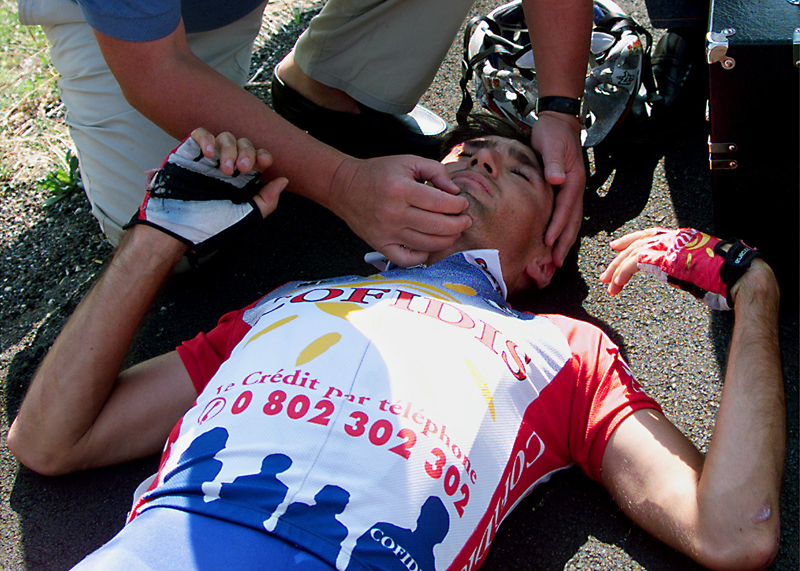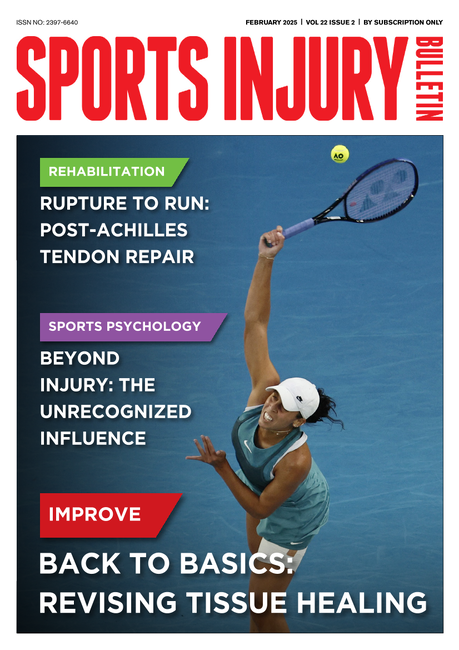Jeremy Windsor outlines the injuries and conditions that triathletes and support professionals must prepare for.From the shortest mass-participation ‘sprint’ races to the elite Ironman events, triathlons have in turn presented health care professionals with fascinating challenges (1). In this article, we highlight some of the key medical issues for competitors and coaches/support staff alike.
Swim hazards
The swim tends to take place in a freshwater lake or river, sometimes in a swimming pool or sheltered area of ocean. Although the swim is often the shortest component of the triathlon, a significant number of medical problems can arise.Hypothermia
Hypothermia is defined as a core temperature below 35 degrees Celsius. As the body cools from its normal 37C, a series of physiological changes occur. Below 32C, heat production stops and core temperature rapidly drops. Victims soon fall unconscious and fatal cardiac arrhythmias occur.How much heat is lost during a swim depends on a combination of environmental and individual factors. While short swims in warm water pose very little risk, in colder waters swimmers need wetsuits to reduce heat loss (see Table, below). In some cases this is not enough. Despite the use of wetsuits, there are numerous reports of hypothermia occurring in thin, slow-moving individuals immersed in cold water for long periods. Competitors should therefore ensure that they are as prepared as possible and appropriately ‘suited up’ for cold water swims.
Traumatic injuries
Unintended collisions are commonplace during races. Injuries to the face and limbs can result either in superficial (skin, nail, hair) or deep (bone, tendon, ligament) tissue damage. To minimise these incidents swimmers wear bright caps and are separated into ‘waves’ of 100 to 200 competitors. The first ‘turn’ in the course should be placed as far away from the start as possible in order to prevent swimmers bunching together. One trained lifeguard for every 25 to 50 swimmers should accompany each ‘wave’. These individuals should be provided with a suitable craft that can access those in difficulties quickly and safely. Powerboats can be dangerous in these situations and should only be summoned in an emergency. The exit and entry points need to be clear of underwater debris and designed so that they funnel finishers along a narrow corridor to allow medical problems to be dealt with quickly.Bacterial infection
Although the danger posed by sharks, jellyfish and other competitors may appear more immediate, the impact of water-borne infections may prove to be a greater concern for triathletes. Leptospirosis and schistosomiasis have both been contracted by triathletes swimming in freshwater lakes and rivers.eptospirosis (Weil’s disease) initially presents as a flu-like illness soon after exposure to the urine of infected animals. After a brief recovery, patients develop a high fever, headache and vomiting, and some go on to develop liver, kidney and brain complications. During the summer of 1998, 876 athletes participated in a triathlon in St Louis, USA(2). Of these, 52 developed leptospirosis and 22 needed hospital treatment.
Schistosomiasis is a parasitic disease caused by a small fluke found in the lakes of Asia, Africa and South America. Rarely fatal, it can cause extensive damage to the liver and gastrointestinal tract. In a study of 30 Zimbabwean triathletes and 24 healthy controls, 80% of the triathletes were found to have schistosomiasis, compared to 38% of the controls (3).
Cycling hazards
The two most common cycling hazards are hyperthermia and traumatic injuries.Hyperthermia
Once out of the water, the triathlete’s core temperature increases rapidly. Typically, temperatures of between 36.5C and 40C are found in exercising athletes during long-distance events. In a small number of cases core temperature continues to rise and the athlete develops hyperthermia (see box, left). This is particularly common in elite athletes producing large quantities of heat in a hot environment.The most effective treatment for hyperthermia is complete immersion in cold water (0C to 18C). If this is not available, ice packs or ice water-soaked towels applied to the neck, groin and axilla (armpit) are also effective. To prevent hypothermia, active cooling should be stopped once the core temperature reaches 39C.Traumatic injuries
Large clusters of cyclists are more likely to collide and sustain a wide range of injuries. While only a few triathlons encourage the wearing of protective clothing, all now insist on the use of cycle helmets, imposing heavy sanctions on those who don’t comply. Carrying a mobile phone or wearing headphones is banned by the International Triathlon Union. As many triathlons share public roads with other users, competitors need to follow local traffic laws carefully – there have been accounts of overseas cyclists on the wrong side of the road.Run hazards
The final component of the triathlon is often the most taxing. Many athletes withdraw during this phase, suffering from musculoskeletal injuries to the lower back and limbs. Other medical problems may also arise.Dehydration
Fluid loss from sweat, urine and exhaled gas can run to several litres per hour. Triathlon Canada and USA Triathlon recommend placing fluid stations every 2km along the course. These provide not only cold water for cooling (tipping over the head, etc), but also drinks containing a mixture of water, glucose and electrolytes. If fluids are not adequately replaced, symptoms rapidly develop and performance nose-dives.Hyponatraemia
In recent years the dangers of hyponatraemia have begun to be taken seriously. Normally, the concentration of sodium in the body’s circulation stays fixed between 135 and 145 mmol/l. During a triathlon, however, this can fall significantly. Although hyponatraemia may in part be caused by salt losses that occur as a result of sweating, in most cases the effect is exaggerated by the consumption of too much water. Those who drink excessive amounts of water and ignore the need to replace salt develop the worst forms of hyponatraemia.One example is the ultra-distance triathlete who drank 23 litres of water during a race, gained 5% in body weight and developed seizures from a depleted sodium concentration of 116 mmol/l (4).
The key to the severity of hyponatraemia is not the absolute concentration of sodium in the plasma, but the rate at which it falls. The quicker the drop-off, the greater the likelihood of developing life-threatening complications. The tired, dizzy triathlete with a mild case of hyponatraemia can become confused and unconscious in just a couple of hours if they continue to exercise and take on large quantities of water.
It is a straightforward matter to treat dehydration, using oral or intravenous fluid containing an isotonic mixture of electrolytes and glucose. But the treatment of hyponatraemia is far more controversial. There is considerable debate over the amount and composition of the fluid required. Since many of those with hyponatraemia will be adequately hydrated, further fluids are not necessary and these individuals should be encouraged to increase their consumption of salty foods. However, some will be both dehydrated and hyponatraemic. For these athletes, the choice is between isotonic and hypertonic fluids, which is where the controversy continues.
UV light exposure
The combination of high temperatures and long periods in the sun makes sunburn a common problem in endurance events. Despite the use of water-resistant sunblock (SPF 25+), Ironman entrants in the 1999 World Championships in Hawaii were exposed during the course of the day to eight times the dose of UV light that is thought sufficient to cause sunburn on normal white skin.Gastrointestinal distress
Gastrointestinal problems are commonplace during the latter stages of a triathlon. In a study of 25,640 French triathletes competing throughout the 1989 season, 8.9% experienced ‘gastric’ symptoms such as nausea, epigastric pain and vomiting, while 8% suffered ‘intestinal’ symptoms such as diarrhoea or abdominal pain (5). These symptoms can be debilitating: 45% of the French athletes described their symptoms as ‘severe’ and 7% of sufferers abandoned the race as a result.What causes these symptoms is unclear. It is assumed that, since blood is directed towards the skin and muscles in exercise, the gastrointestinal tract does not receive its normal flow of nutrients. Although this is tolerated comfortably during short bouts of exercise, during extreme triathlon events large swathes of cells are lost.
Sometimes, pain in the right iliac fossa can persist for several days after an event, which has been attributed to a condition known as the ‘caecal slap syndrome’(6). Here, the athlete’s caecum (pouch at the start of the large bowel) becomes bruised after repeated ‘slaps’ made with the anterior abdominal wall during running. A similar explanation is given for the presence of blood in the urine of long-distance runners (7). Because the bladder makes contact with the abdominal wall with each foot strike, after many thousands of impacts a traumatic injury results.
Conclusion
The sport of triathlon provides competitors and health professionals with extraordinary challenges. Studies have revealed that during Ironman events, up to 17% of competitors require some form of medical treatment. This is a high level of demand on race support medics, so it is vital that all those involved in the sport are aware of the health risks and are able to prepare accordingly.Jeremy Windsor is clinical lecturer in intensive care at the Whittington Hospital, London and honorary lecturer in physiology at University College London.
References
1. Hiller W, et al. Medical and physiological considerations in triathlon. Am J Sports Med 1987;15:164-7.
2. Guarner J, et al. Leptospirosis mimicking acute cholecystitis among athletes participating in triathlon. Hum Pathol 2001;32:750-2.
3. Jeans A, Schwellnus M. The risk of schistosomiasis in Zimbabwean triathletes.
S Afr Med J 1994;84:
756-8.
4. Speedy DB, et al. Hyponatraemia and seizures in an ultradistance triathlete.
J Emerg Med 2000;
18:41-4.
5. Lopez AA, et al. Digestive disorders and self medication observed during a competition in endurance athletes: prospective epidemiological study during a championship of triathlon. Gastroenterol Clin Biol 194;18:317-22.
6. Porter AMW. Marathon running and the caecal slap syndrome. Brit J Sports Med 1982;16(3):178.
7. Blacklock NJ. Bladder trauma in the long distance runner – 10,000 metres haematuria. Brit J Urol 1977;49:129-32.









